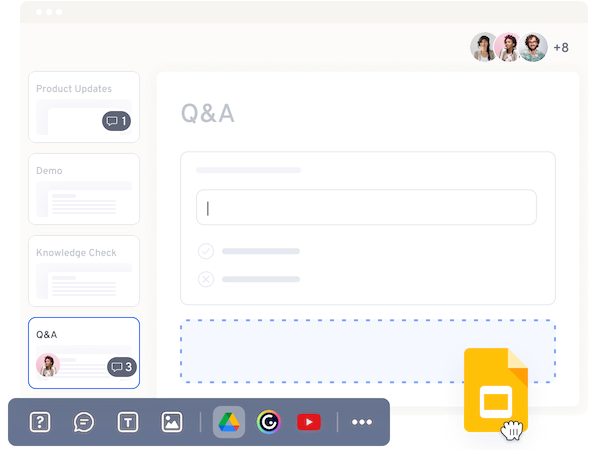What is learning management system software?
Learning management system software, or LMS software, is an application built for planning, implementing, and assessing learning processes. It provides organizations and educational institutions with tools to craft and manage lessons, courses, documentation, certifications, and quizzes to make learning more engaging and effective. An LMS can be a standalone product or part of a broader suite of HR tools.
With an LMS solution, instructors can create and deliver content, monitor learner participation, and evaluate performance. Learning management system software is also designed to streamline processes for training and development departments, such as identifying and assessing individual and organizational learning goals, tracking progress towards meeting those goals, and collecting data.
Businesses of all sizes, government agencies, and educational institutions use LMS platforms to facilitate training and other education programs. The software improves upon traditional educational methods while saving organizations time and money. Moreover, the software can facilitate employee onboarding, compliance training, and skills gap analysis for enterprises.
We reviewed the top LMS software solutions and narrowed it down to the best of the best:
- Paylocity is the best LMS for interactive learning.
- Rippling is the best LMS for automated workflows.
- Docebo is the best LMS for artificial intelligence support.
- Absorb LMS is the best LMS for analytics.
- 360Learning is the best LMS for collaborative course creation.
Our picks for the best LMS software
Paylocity: Best for interactive learning
Pros
Cons

Rippling: Best for automated workflows
Pros
Cons

Docebo: Best for artificial intelligence support
Pros
Cons

Absorb LMS: Best for analytics
Pros
Cons

360Learning: Best for collaborative course creation
Pros
Cons

Find your new learning management system software
What are the benefits of learning management system software?
Regardless of the business type, learning management system software solutions can provide users and organizations with numerous benefits.
Saves time and money
Without a robust LMS, learners have to take time out of their day to physically attend traditional face-to-face training. With LMS platforms, learners simply log into the system and complete courses at the time most convenient for them.
Additionally, costs can be cut by eliminating the need for live instructors, training days, printed training materials, travel expenses, and facility rentals.
Improves remote accessibility
Most learning management systems support virtual type of training and enable organizations to build learning programs for every employee, regardless of location and time zone. Once the admin publishes eLearning course materials onto the system, learners can access the information they need.
Many software providers make learning modules accessible from smartphones and tablets, too, so users can reference materials in the field or on the go. Further, learners can return to a lesson to refresh their memory anytime they need to because the materials are hosted online.
Centralizes and standardizes training
LMS platforms centrally organize training and keep professional development content in one location. As a result, companies can reduce the risk of losing important information when subject matter experts leave the business. An LMS secures training materials, such as PowerPoint or PDF documents, video files, quizzes, assessments, and certifications.
Monitors learner progress and performance
Companies and educational organizations can generate training reports on an overall or learner-level basis to pinpoint areas where a course may be lacking, as well as where it excels. LMS solutions allow instructors to check learner progress and ensure they meet performance metrics. Business leaders can track goal progress, knowledge gains, and ROI.
Helps businesses maintain compliance
Numerous industries — including oil and gas, pharmaceuticals, communications, and construction — are required to train employees and report against specific compliance metrics to maintain funding. An LMS helps the organization meet these legal and regulatory requirements.
In addition, learning management systems let businesses add new compliance standards to their training courses. This way, learners are always updated on the latest best practices, avoiding costly penalties for the organization.
What are the types of learning management system software?
Learning management system software can be classified according to implementation or purpose.
The business impact of LMS software
Manually tracking the learning processes of every employee in an organization can be overwhelming and difficult. Above a certain headcount, it becomes increasingly impractical for learning and development (L&D) professionals to monitor each worker’s current industry knowledge, find out what learning modules they need to master their skills, keep an eye on their learning engagement levels, and so on.
With LMS software, instructors can keep all training materials organized and ensure all employees receive up-to-date training for their specific jobs, no matter where they are. In fact, an LMS can be the best option for global companies that are unable to deliver instructor-led training to employees in remote locations.
The software guarantees learning consistency and continuous employee development across multiple worksites and regions — overcoming knowledge and skill gaps and achieving better results.
On top of that, using LMS platforms reduces training costs and cut down on total time spent in training. LMS solutions also give flexibility, empowering instructors to conduct training via video, interactive content, games, text, and audio. The availability of diverse training resources can improve employee experience and prepare workers to advance their careers, resulting in increased performance and higher employee retention.










